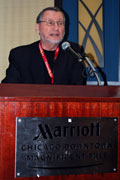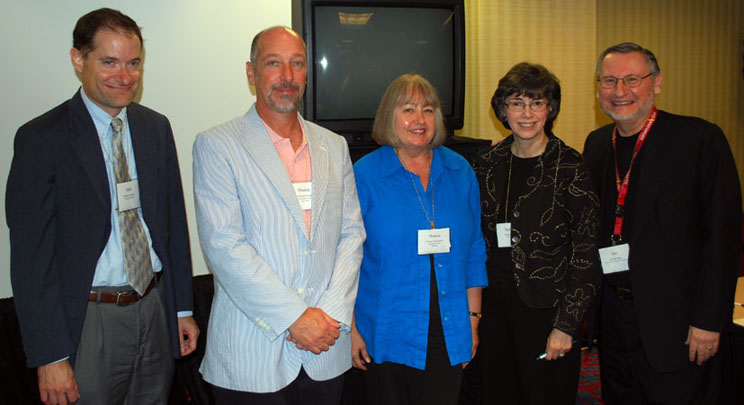
THE ASSOCIATION FOR EDUCATION FOR JOURNALISM AND MASS COMMUNICATION (AEJMC) in Chicago
featured a PF&R Panel sponsored by
the Entertainment Studies Interest Group and the Magazine Division
on “The Image of the War Correspondent in Popular Culture”
11:45 a.m., Thursday, August 7, 2008.
 Joe Saltzman, director of the Image of the Journalist in Popular Culture at USC Annenberg's Norman Lear Center, moderated a panel that explored the journalist as war correspondent in movies, television, graphic novels and fiction.
Joe Saltzman, director of the Image of the Journalist in Popular Culture at USC Annenberg's Norman Lear Center, moderated a panel that explored the journalist as war correspondent in movies, television, graphic novels and fiction.
Saltzman played a 14-minute video compiled from a four-hour long IJPC video called "The Image of the War Correspondent in Movies and TV, 1931 to 2007." It showed clips of often-heroic journalists in movies such as The Green Berets (starring John Wayne), Ernie Pyle's The Story of G.I. Joe, and Blood Diamond.

Panelist Matthew Ehrlich (pictured above with panelists and Saltzman, far left) examined The Story of G.I. Joe and said Ernie Pyle is probably the most famous war correspondent of all time.
"The story of G.I. Joe is a film that in the words of Pyle's biographer 'blended myth and reality in about the same proportions as the movie that inspired it.'" Ehrlich said. "Even as both the movie and the real-life journalist showed the 'grim ironies' of war, they also suggested that the men fighting it on the ground were noble and that the press' proper place was on the men's side."
Panelist Howard Good discussed war correspondents in graphic novels, Norma Green spoke about the portrayal of women journalists in war zones in movies, and Sammye Johnson lectured on the female war correspondent in fictional books.
Johnson said there are biases that come along with being a female war correspondent in popular culture.
"You have trouble proving yourself as a woman in a male-dominated field," she said. "There seems to be an underlying theme in books that beautiful women are getting ahead because of their looks."
Saltzman said the journalist as war correspondent became a national folk hero in the 1940s. "In the movies, popular actors couldn't wait to play the glamorous overseas war reporter who would save the day, his loved one and his county in less than a couple hours," he said. "The war correspondent was the perfect movie hero whose daily work included patriotism, danger, violence and drama."
Saltzman concluded: "The image of the war correspondent is one of the most exciting in all of popular culture — often glamorizing the profession but also occasionally showing the bravery and day-to-day toughness war correspondents have to have both in fiction and in real life."